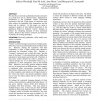Free Online Productivity Tools
i2Speak
i2Symbol
i2OCR
iTex2Img
iWeb2Print
iWeb2Shot
i2Type
iPdf2Split
iPdf2Merge
i2Bopomofo
i2Arabic
i2Style
i2Image
i2PDF
iLatex2Rtf
Sci2ools
ICHIM
2001
2001
Electronic Guidebooks and Visitor Attention
We describe an electronic guidebook prototype and report on a study of its use in a historic house. Supported by mechanisms in the guidebook, visitors constructed experiences that had a high degree of interaction with three entities: the guidebook, their companions, and the house and its contents. In this paper, we report a qualitative analysis of how different properties of the guidebook helped or hindered visitors' attempts to balance the competing demands of these attentional entities. Based on the visitors' comments and behavior, we distill a set of design principles.
| Added | 31 Oct 2010 |
| Updated | 31 Oct 2010 |
| Type | Conference |
| Year | 2001 |
| Where | ICHIM |
| Authors | Allison Woodruff, Paul M. Aoki, Amy Hurst, Margaret H. Szymanski |
Comments (0)

